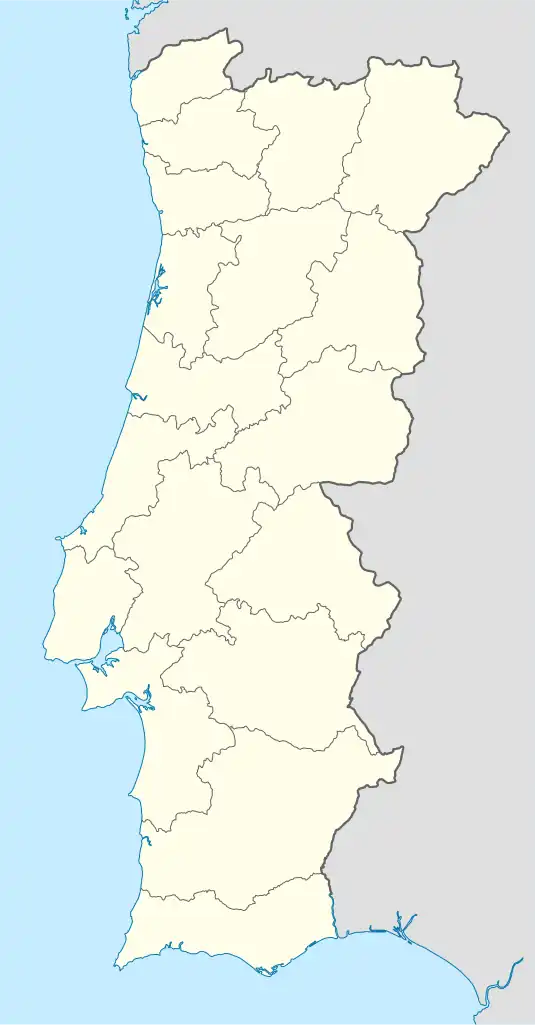Sanhoane was a Portuguese parish in the municipality of Mogadouro, Portugal. In the 2012/2013 administrative reorganisation, it became the seat of the Brunhozinho, Castanheira and Sanhoane parish union.[1]
Sanhoane | |
|---|---|
.jpg.webp) Coat of arms | |
 Sanhoane Location in Portugal | |
| Coordinates: 41°22′46″N 6°33′59″W / 41.37944°N 6.56639°W | |
| Country | |
| Region | Norte |
| Intermunic. comm. | Trás-os-Montes |
| District | Bragança |
| Municipality | Mogadouro |
| Area | |
| • Total | 12.68 km2 (4.90 sq mi) |
| Population (2011[2]) | |
| • Total | 126[3] |
| Time zone | UTC±00:00 (WET) |
| • Summer (DST) | UTC+01:00 (WEST) |
Geography
Sanhoane covered an area of 1268 hectares.[4] Located in the centre of the Mirandese plateau, more specifically on the highest slopes of the mountain massif known as Serra de Mogadouro, it is 15 kilometres from the county seat. The landscape is generally flat, but there is one high point worth mentioning: the Castelico, the highest point in this ancient parish and from where you can see a vast horizon stretching into Spain.
The former parish of Sanhoane bordered Saldanha to the north, Castanheira to the north-west, Travanca to the north-east, Penas Roias to the south-west, Brunhozinho to the south-east and Tó to the south.
The large Fonte da Pedra lagoon is located in a small valley and is crossed by the road that serves this old parish, where fishing is practised and it is an inviting place for recreation and leisure, where you can enjoy a good snack under the leafy trees that surround it.
History
The place's name goes back to the early days of life in Sanhoane, in Castrogelo, a primitive settlement in the area, that still shows great traces of its existence, such as stones from hand mills, ceramic and metal pieces, and funerary stelae of Roman origin.
The curious name of this ancient parish seems to be derived from its patron saint, John the Baptist. In fact, until the 15th century, it was very common to identify it as San Oane, Sago Ane or San One, a name that over the centuries or with the ease of the language came to be called Sanhoane.
Until the 19th century, Sanhoane belonged to the municipality of Penas Roias. In addition to Sanhoane, the villages of Castanheira, São Martinho do Peso, Macedo do Peso, Peso, Vilariça, Variz, Viduedo and Sampaio were also part of the municipality. In 1801 the municipality had 1560 inhabitants
On 22 May 1938, the railway line between Mogadouro, and Duas Igrejas, in the municipality of Miranda do Douro, was opened. On this section, within the Sabor line, there was a stop near the village of Sanhoane (Sanhoane halt). On 1 August 1988, the line was closed and the halt was dismantled.
Heritage and Tourism
Points of interest
This ancient parish has a small cultural and built heritage, but it is worth visiting:
- The Church of Sanhoane, with just one nave supported by three Romanesque arches and three altars with beautiful images.
- Chapel of Santo Amaro (Sanhoane), a large temple with just one altar and two panels where we are told a legend relating to the miraculous saint and a member of the Távoras, a nobleman from Quinta de Nogueira, near Mogadouro, who tried to kidnap him for the chapel of his quinta, but the miraculous saint caused the horse he was riding to break a leg and its owner turned to the saint and promised him that if the animal got better he would put it back on his altar and have the temple enlarged. And so it happened. This grandiose temple also has a surrounding area surrounded by a granite wall that houses the House of Miracles for the payment of promises made to the miraculous saint.
- A large number of dovecotes, characteristic of this area.
- Preserved diving fountain and tumuli.
Handicrafts
Weaving, woollen rugs, lace quilts and wicker basketry.
Gastronomy
Enchidos, presunto, Easter folar, cascas de bulho, mirandese steak.
Festivals
- Saint Amaro - 15th January (saint's day)
- Saint Amaro - 3rd Sunday in July (traditionally celebrated on the 3rd Sunday in June until 2006)
- Saint Barbara - 1st weekend in September - Saturday
- Saint John - 24th June
Access
Railway
Sabor line (closed)
Road
IC5
Pópulo - Carrazeda de Ansiães - Vila Flor - IP2 - Alfândega da Fé - Mogadouro - Sanhoane - Bemposta (Mogadouro) - Duas Igrejas
EN221
Guarda - Pinhel - Figueira de Castelo Rodrigo - Freixo de Espada à Cinta - Mogadouro - Sanhoane - Miranda do Douro
CM1163
IC5/EN221 - Sanhoane - EM600-1
Population
| Totals and age groups[5] | |||||||||||||||
|---|---|---|---|---|---|---|---|---|---|---|---|---|---|---|---|
| 1864 | 1878 | 1890 | 1900 | 1911 | 1920 | 1930 | 1940 | 1950 | 1960 | 1970 | 1981 | 1991 | 2001 | 2011 | |
| 277 | 244 | 262 | 275 | 287 | 281 | 266 | 365 | 329 | 346 | 258 | 258 | 179 | 149 | 126 | |
| i) | 12 | 8 | |||||||||||||
| ii) | 15 | 8 | |||||||||||||
| iii) | 78 | 58 | |||||||||||||
| iv) | 44 | 52 | |||||||||||||
i) 0-14; ii) 15-24; iii) 25-64; iv) 65 and older
References
- ↑ Diário da República, 1.ª Série, n.º 19, Reorganização administrativa do território das freguesias, Lei n.º 11-A/2013, de 28 de janeiro, Anexo I. Acedido a 19/07/2013.
- ↑ INE (2012) – "Censos 2011 (Dados Definitivos)", "Quadros de apuramento por freguesia" (tabelas anexas ao documento).
- ↑ INE (2012) – "Censos 2011 (Dados Definitivos)", "Quadros de apuramento por freguesia" (tabelas anexas ao documento).
- ↑ Instituto Geográfico Português, Carta Administrativa Oficial de Portugal (CAOP), versão 2012.1
- ↑ Instituto Nacional de Estatística (Recenseamentos Gerais da População) - https://www.ine.pt/xportal/xmain?xpid=INE&xpgid=ine_publicacoes